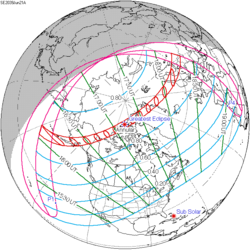| Total eclipse | |
| Gamma | 0.1763 |
|---|---|
| Magnitude | 1.0485 |
| Maximum eclipse | |
| Duration | 268 s (4 min 28 s) |
| Coordinates | 12°S109°W / 12°S 109°W |
| Max. width of band | 164 km (102 mi) |
| Times (UTC) | |
| Greatest eclipse | 19:15:39 |
| References | |
| Saros | 130 (43 of 73) |
| Catalog # (SE5000) | 9172 |
A total solar eclipse occurred at the Moon's descending node of orbit on Wednesday, November 30, 1853, with a magnitude of 1.0485. A solar eclipse occurs when the Moon passes between Earth and the Sun, thereby totally or partly obscuring the image of the Sun for a viewer on Earth. A total solar eclipse occurs when the Moon's apparent diameter is larger than the Sun's, blocking all direct sunlight, turning day into darkness. Totality occurs in a narrow path across Earth's surface, with the partial solar eclipse visible over a surrounding region thousands of kilometres wide. Occurring about 8.5 hours before perigee (on December 1, 1853, at 3:45 UTC), the Moon's apparent diameter was larger. [1]
Contents
- Observations
- Eclipse details
- Eclipse season
- Related eclipses
- Eclipses in 1853
- Metonic
- Tzolkinex
- Half-Saros
- Tritos
- Solar Saros 130
- Inex
- Triad
- Solar eclipses of 1852–1855
- Saros 130
- Metonic series
- Tritos series
- Inex series
- References
The path of totality was visible from parts of modern-day Peru, Bolivia, and Brazil. A partial solar eclipse was also visible for parts of northern Oceania, Hawaii, southern North America, Central America, the Caribbean, and South America.






































































































